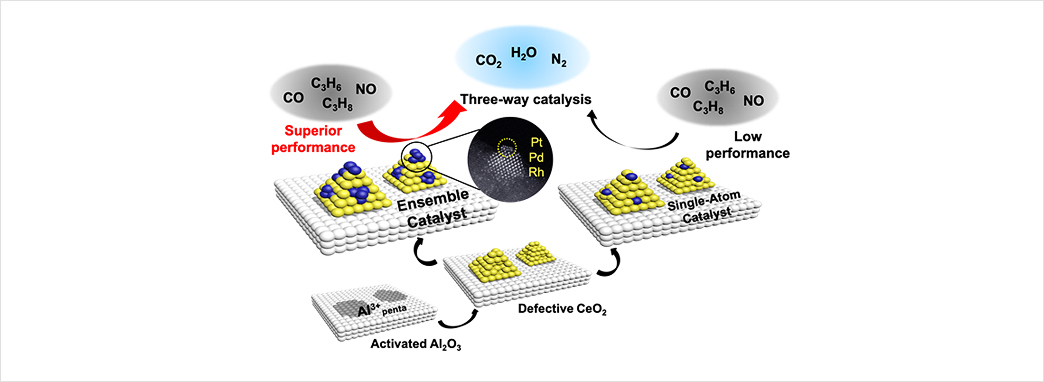
The research team led by Prof. Hyunjoo Lee has developed a high-performance, fully dispersed metal ensemble catalyst that can be used as an automobile catalyst. The research team's metal ensemble catalyst showed superior performance at low temperature, compared to conventional catalysts in three-way catalysis (TWC), which is a gasoline vehicle exhaust gas purification reaction. In addition, it exhibited excellent performance in durability text such as aging and long-term reaction. The metal ensemble catalyst of the research team is expected to be of high value in the field of heterogeneous catalysts, surpassing the existing single atom catalysts. This research result was published in Nature Catalysis (titled "Highly durable metal ensemble catalysts with full dispersion for automotive applications beyond single-atom catalysts").
Among various heterogeneous catalysts, noble metal (platinum, palladium, rhodium) based catalysts are widely utilized because of their high activity, but are limited due to the scarcity and high price of noble metals. Therefore, maximizing the efficiency remains a very important task. Single-atom catalysts are extensively used because all metal atoms can participate in catalytic reactions; however, they are not able to exhibit catalytic performance in the reactions which requrie ensemble sites.
On the other hand, gasoline vehicle exhaust gas consists of carbon monoxide (CO), propylene (C3H6), propane (C3H8), and nitrogen monoxide (NO), and such pollutants should be converted to carbon dioxide (CO2), water (H2O), nitrogen (N2) through a three-way catalytic reaction prior to discharge. For such conversion, the oxidation of hydrocarbons (propylene, propane) proceeds only when the carbon-carbon and carbon-hydrogen bonds are broken; therefore, it is essential to secure a metal ensemble site for the catalytic reaction.
To solve the problem, the research team developed a metal (platinum, palladium, rhodium) ensemble catalyst with full dispersion and applied it to a three-way catalytic reaction. In that way, all metal atoms are exposed on the surface, participating in the reaction. This is a characteristic of a single atom catalyst, while the ensemble catalyst has the advantage of a full dispersion and an ensemble site with two or more atoms attached thereto.
As a result, the metal ensemble catalyst showed an excellent low-temperature catalytic performance in a three-way catalytic reaction in which carbon monoxide (CO), propylene (C3H6), propane (C3H8), and nitrogen monoxide (NO) were simultaneously removed. This solves the problem of single-atom catalysts in which three-way catalyst performance is deteriorated due to lack of hydrocarbon oxidation reaction performance. In particular, the full dispersion metal ensemble catalyst developed by the research team presents excellent performance in durability tests such as hydrothermal aging, long-term reaction, and reuse test, and it is expected to be applicable to gasoline vehicle exhaust gas purification.
Professor Hyunjoo Lee said, "This metal ensemble catalyst has a great academic contribution as a new metal catalyst that overcomes the limitations of the existing single-atom catalyst. Also, it is industrially applicable to the field of gasoline vehicle exhaust gas purification catalysts, so the research is very valuable."





